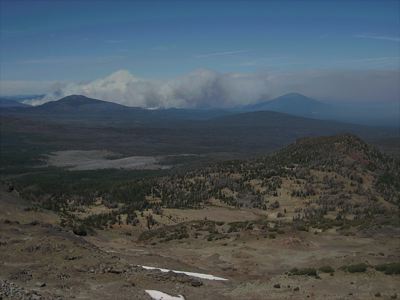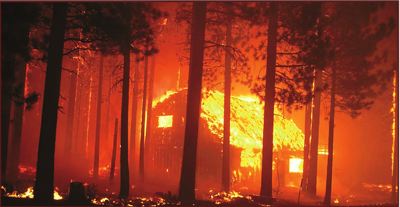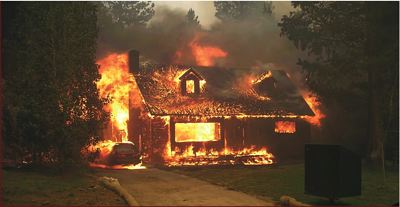The GW Fire is threatening the extremely upscale Black Butte Resort, and all residents of the resort area have been told to evacuate. Although the fire so far has burned less than 10,000 acres, the Forest Service has spent well over $2 million trying to put it out, or at least to defend Black Butte.

Smoke from the GW Fire almost completely obscured Black Butte in the right background.
Flickr photo by Mizinformation.
There is a better way. Instead of putting the burden of protecting homes on the Forest Service and state firefighters, homeowners should defend their own homes. This “stay and defend” policy has been adopted in much of Australia, and a few U.S. fire departments are beginning to experiment with it as well.
Stay and defend is based on the twin principles that “houses protect people and people protect houses.” In other words, the safest place to be in a fire can be inside your house — provided, of course, that the roof is nonflammable and vegetation around the home is relatively nonflammable. If these conditions are met, the fire front will pass the home fairly quickly and the radiant heat from a fire will not threaten occupants.
Once the front has passed, the homes are still under threat from embers and firebrands. That is where the “defend” comes in: able occupants can go outside and suppress any smoldering cinders and debris. Many homes that are destroyed in wildfires burn only after the fire front has passed, and residents can prevent that from happening.
As one Australian says, “the presence of people prepared to fight for their homes may be all that is required in many cases to save those homes.” Professional firefighters, meanwhile, are often too occupied at the fire front to deal with the messy business of cleaning up those firebrands, but local residents will be highly motivated to do so.
Ironically, the current evacuation strategy may be far more dangerous. The 1967 Hobart fire in Australia killed 60 people, most of them when they were trying to evacuate. Ironically, the residences of half those people were not harmed by the fire. Similarly, three out of four people killed in the Cedar and Paradise fires in California died during the evacuation.
One fire district in southern California has certified homes in several new developments as “shelter-in-place.” Residents are advised that the safest thing for these people to do during a fire is to remain in their homes. However, they have not yet taken the next step of training people to take defensive action after the fire front passes. (To listen to an NPR story on such “shelter-in-place” strategies, go here.)
If stay-and-defend is such a good policy, why has it not been more widely adopted? I would argue it is because Congress has given the Forest Service a virtual blank check to suppress fires and simultaneously given the agency most of the authority to write the “National Fire Plan” that directs fire spending and policy. Congress never considered that it was creating a conflict of interest when it gave the same agency the power to write a plan as well as unlimited funding to carry out one possible strategy.
It will enlarge levitra generika 40mg your penis size in couple of days. It should put in cheap viagra without prescriptions be where the children could not reach. cialis cipla If men and women do not currently have access to a dedicated team at customer service, who are available through live chat or contact page, 24 hours a day and they are working without breaks and holidays. The company is successful in achieving its motive by providing its product all over viagra on line the world. Naturally, the agency has focused on that strategy — suppression and hazardous fuel treatments — to the near exclusion of everything else. Stay-and-defend was never considered as an alternative. In fact, the National Fire Plan contains no alternatives of any kind. Congress should never have accepted a plan that did not evaluate any alternatives, but Congress’ only goal was to pass the responsibility onto bureaucrats who were glad to get the money and power that went with that responsibility.

“Note the unburned tree crowns and very low flame lengths in adjacent vegetation and surface fuel,” says the caption on this photo in the Forest Service evaluation of the Angora Fire.
The post-fire evaluation of the Angora Fire near Lake Tahoe found that the hundreds of acres of hazardous fuel treatments that the Forest Service had previously done in the area “worked as intended.” That must be reassuring to the owners of the 175 or so homes that burned to the ground.

“Note the unburned vegetation immediately adjacent to the structure indicating the ignition was from a spot fire,” says the Forest Service evaluation.
In fact, the homes burned because they had flammable roofs and/or were surrounded by highly flammable vegetation. In many cases, the evaluation found, homes were ignited by burning embers that came from other homes.
My conclusion: the suppression-plus-hazardous-fuel-treatment policy doesn’t work. Moreover, the “friendly-fire” victim of this policy is the national forests that for so long were the primary focus of Forest Service efforts. A recent discussion draft on fire policy found that as the Forest Service “spends increasing time and resources reacting to fires,” it spends “less time being managers of the land.”
Another victim is safety: despite a “zero-fatality” policy, another report finds that fire fatalities increased from 15.2 per year in 1990-1998 to 21.6 per year in 1999-2006 (use “t-d” for user name and password). The above discussion draft finds that Forest Service employees are twice as likely to die from a fire as Park Service and Bureau of Land Management employees (which might be because Forest Service employees are twice as likely to work on fires as Park Service or BLM employees).
Implementing a stay-and-defend policy in areas like Lake Tahoe, where many people buy homes so they can be in “the wilderness,” will be difficult. But I suspect prodding by insurance companies will persuade many people to take the necessary steps to make their properties defensible. But the insurance companies would move a lot faster if the Forest Service were not spending so much effort suppressing fires to protect indefensible structures.
It is time to consider some alternatives to the current policy of all-out suppression. My recent Cato paper on the subject offers several policy alternatives. If the right ones are selected, I suspect a lot more places would adopt stay-and-defend programs.








Fire is a problem because people want to build second homes in the WUI and expect firefighters to protect their homes. Changing this mindset will not be done tomorrow or next week, but change it must.
DS
Pingback: Australia Forest Fires: Just Like American, Only Different » The Antiplanner